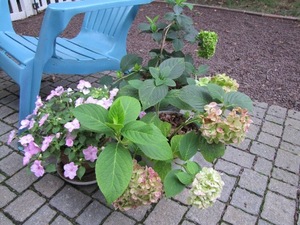Mophead hydrangea shrubs (Hydrangea macrophylla) offer large blue or pink blooms. The blooms appear on dome-shaped deciduous shrubs for one to three months starting in early to mid-summer. Macrophylla hydrangea shrubs are a perfect source of flowers for floral arrangements or for drying for crafts. I am fond of hydrangea for its ease in propagating through layering or cuttings. It was that ease in getting new hydrangea shrubs that led me to grow hydrangea in pots. I have potted hydrangea outdoors on a patio, where hydrangea enjoys the partial shade.
About potted hydrangea
The value of having a hydrangea shrub in a pot is that you can locate the pot to a desired location in the landscape. I found relocating potted hydrangea a handy way to redirect foot traffic or to create a focal point such as in the shade garden or on the patio. Hydrangea can survive winters at least as far north as USDA planting zone 6 according to The United States National Arboretum. A USDA planting zone number indicates whether the shrub can withstand the winter in your area. Macrophylla hydrangea reaches about 5 feet tall and wide if not pruned.
Choosing shrub containers
The root system of hydrangea grows quickly as does the leafing portion of the shrub. I start my hydrangea cuttings in a small pot about 6 inches in diameter. After one year, I transplant the hydrangea to a medium pot about 8 to 10 inches across. After two to three years in the medium size pot, I transfer the hydrangea again to a pot about 24 inches across. The hydrangea remains in the large pot indefinitely.
The container used for hydrangea shrubs must have drain holes. The measurement across the top of the container matches the anticipated horizontal root growth. For the small and medium size pots, I choose inexpensive plastic pots, the kind where the plastic is somewhat pliable. That is, you can partially distort the shape of the pot by squeezing it between your hands. For the large and final pot size, I choose sturdy plastic that cannot be bent so it can handle a large volume of soil. I advise plastic containers for shrubs because they can withstand the cold winter temperatures that may crack some pottery or ceramic pots. In addition, I add bricks to the bottom of the large container to help prevent the shrub from tipping over on windy days. I have a plant dolly with large casters on which to place a heavy flower pot, making it easier to move the flower pot to clean behind it.
Where to place potted hydrangea
Place the pot in a partial shade location outdoors. Filtered sunlight is optimal, where small dots of sun hit the ground through a canopy of a tree, but morning sun and afternoon shade is acceptable. In the house, place the potted hydrangea near a sunny window but not directly in front of a sunny window. Around September, place indoor potted hydrangea outdoors and allow them to remain outdoors until the following spring.
Additional care
Potted hydrangeas outdoors may require watering daily during dry, hot periods. I can tell if my plant needs water by lifting or tipping the pot-too light means more water is needed. Otherwise, push your finger into the soil 1 to 2 inches to feel if the soil is moist. I don’t fertile my hydrangea but a fertilizer specifically formulated for hydrangea, such as Miracle-Gro Azalea, Camellia & Rhododendron, can be applied according to the manufacturer’s instructions. Spreading a layer of mulch, like pine bark chips, around the shrub will help block weed growth from seeds floating on the wind that then land on a potted hydrangea.
Prune broken stems as they occur. Additional pruning is not needed; however, you may prune hydrangea to maintain a preferred size. If you prune your hydrangea, do so before August to avoid cutting off buds that set blooms for the following season.
Sources: Janet Carson, “Hydrangea,” University of Arkansas Cooperative Extension Service; Plant Hardiness Zone Map, United States Department of Agriculture Research Service; “Hydrangea Questions and Answers,” The United States National Arboretum
